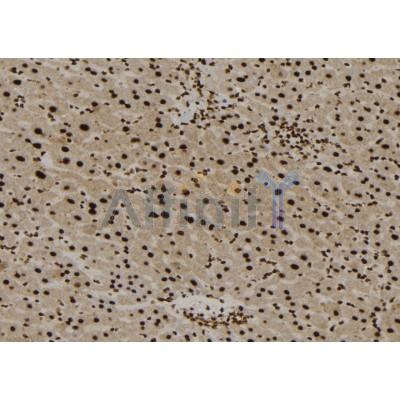AIFM1 Antibody - #DF7021
| Product: | AIFM1 Antibody |
| Catalog: | DF7021 |
| Description: | Rabbit polyclonal antibody to AIFM1 |
| Application: | WB IHC IF/ICC |
| Reactivity: | Human, Mouse, Rat |
| Prediction: | Pig, Zebrafish, Bovine, Horse, Sheep, Rabbit, Dog, Chicken, Xenopus |
| Mol.Wt.: | 66kDa; 67kD(Calculated). |
| Uniprot: | O95831 |
| RRID: | AB_2838977 |
Related Downloads
Protocols
Product Info
*The optimal dilutions should be determined by the end user. For optimal experimental results, antibody reuse is not recommended.
*Tips:
WB: For western blot detection of denatured protein samples. IHC: For immunohistochemical detection of paraffin sections (IHC-p) or frozen sections (IHC-f) of tissue samples. IF/ICC: For immunofluorescence detection of cell samples. ELISA(peptide): For ELISA detection of antigenic peptide.
Cite Format: Affinity Biosciences Cat# DF7021, RRID:AB_2838977.
Fold/Unfold
AIFM1; AIFM1_HUMAN; Apoptosis inducing factor 1, mitochondrial; Apoptosis inducing factor; Apoptosis inducing factor, mitochondrion associated, 1; Apoptosis-inducing factor 1; CMTX4; COWCK; COXPD6; Harlequin; Hq; mAIF; MGC111425; MGC5706; mitochondrial; Neuropathy, axonal motor-sensory, with deafness and mental retardation; neuropathy, axonal, motor-sensory with deafness and mental retardation (Cowchock syndrome); PDCD 8; PDCD8; Programmed cell death 8 (apoptosis inducing factor); Programmed cell death 8; Programmed cell death 8 isoform 1; Programmed cell death 8 isoform 2; Programmed cell death 8 isoform 3; Programmed cell death protein 8; Programmed cell death protein 8 mitochondrial; Programmed cell death protein 8 mitochondrial precursor; Programmed cell death protein 8 mitochondrial precursor; Striatal apoptosis inducing factor;
Immunogens
A synthesized peptide derived from human AIFM1, corresponding to a region within C-terminal amino acids.
Expressed in all tested tissues (PubMed:16644725). Detected in muscle and skin fibroblasts (at protein level) (PubMed:23217327).
Brain specific.
Expressed in all tested tissues except brain.
Isoform 5 is frequently down-regulated in human cancers.
- O95831 AIFM1_HUMAN:
- Protein BLAST With
- NCBI/
- ExPASy/
- Uniprot
MFRCGGLAAGALKQKLVPLVRTVCVRSPRQRNRLPGNLFQRWHVPLELQMTRQMASSGASGGKIDNSVLVLIVGLSTVGAGAYAYKTMKEDEKRYNERISGLGLTPEQKQKKAALSASEGEEVPQDKAPSHVPFLLIGGGTAAFAAARSIRARDPGARVLIVSEDPELPYMRPPLSKELWFSDDPNVTKTLRFKQWNGKERSIYFQPPSFYVSAQDLPHIENGGVAVLTGKKVVQLDVRDNMVKLNDGSQITYEKCLIATGGTPRSLSAIDRAGAEVKSRTTLFRKIGDFRSLEKISREVKSITIIGGGFLGSELACALGRKARALGTEVIQLFPEKGNMGKILPEYLSNWTMEKVRREGVKVMPNAIVQSVGVSSGKLLIKLKDGRKVETDHIVAAVGLEPNVELAKTGGLEIDSDFGGFRVNAELQARSNIWVAGDAACFYDIKLGRRRVEHHDHAVVSGRLAGENMTGAAKPYWHQSMFWSDLGPDVGYEAIGLVDSSLPTVGVFAKATAQDNPKSATEQSGTGIRSESETESEASEITIPPSTPAVPQAPVQGEDYGKGVIFYLRDKVVVGIVLWNIFNRMPIARKIIKDGEQHEDLNEVAKLFNIHED
Predictions
Score>80(red) has high confidence and is suggested to be used for WB detection. *The prediction model is mainly based on the alignment of immunogen sequences, the results are for reference only, not as the basis of quality assurance.
High(score>80) Medium(80>score>50) Low(score<50) No confidence
Research Backgrounds
Functions both as NADH oxidoreductase and as regulator of apoptosis. In response to apoptotic stimuli, it is released from the mitochondrion intermembrane space into the cytosol and to the nucleus, where it functions as a proapoptotic factor in a caspase-independent pathway. The soluble form (AIFsol) found in the nucleus induces 'parthanatos' i.e. caspase-independent fragmentation of chromosomal DNA (By similarity). Binds to DNA in a sequence-independent manner. Interacts with EIF3G, and thereby inhibits the EIF3 machinery and protein synthesis, and activates caspase-7 to amplify apoptosis. Plays a critical role in caspase-independent, pyknotic cell death in hydrogen peroxide-exposed cells. In contrast, participates in normal mitochondrial metabolism. Plays an important role in the regulation of respiratory chain biogenesis by interacting with CHCHD4 and controlling CHCHD4 mitochondrial import.
Has NADH oxidoreductase activity. Does not induce nuclear apoptosis.
Pro-apoptotic isoform.
Under normal conditions, a 54-residue N-terminal segment is first proteolytically removed during or just after translocation into the mitochondrial intermembrane space (IMS) by the mitochondrial processing peptidase (MPP) to form the inner-membrane-anchored mature form (AIFmit). During apoptosis, it is further proteolytically processed at amino-acid position 101 leading to the generation of the mature form, which is confined to the mitochondrial IMS in a soluble form (AIFsol). AIFsol is released to the cytoplasm in response to specific death signals, and translocated to the nucleus, where it induces nuclear apoptosis in a caspase-independent manner.
Ubiquitination by XIAP/BIRC4 does not lead to proteasomal degradation. Ubiquitination at Lys-255 by XIAP/BIRC4 blocks its ability to bind DNA and induce chromatin degradation, thereby inhibiting its ability to induce cell death.
Mitochondrion intermembrane space. Mitochondrion inner membrane. Cytoplasm. Nucleus. Cytoplasm>Perinuclear region.
Note: Proteolytic cleavage during or just after translocation into the mitochondrial intermembrane space (IMS) results in the formation of an inner-membrane-anchored mature form (AIFmit). During apoptosis, further proteolytic processing leads to a mature form, which is confined to the mitochondrial IMS in a soluble form (AIFsol). AIFsol is released to the cytoplasm in response to specific death signals, and translocated to the nucleus, where it induces nuclear apoptosis (PubMed:15775970). Colocalizes with EIF3G in the nucleus and perinuclear region (PubMed:17094969).
Mitochondrion intermembrane space. Mitochondrion inner membrane.
Note: Has a stronger membrane anchorage than isoform 1.
Mitochondrion. Cytoplasm>Cytosol.
Note: In pro-apoptotic conditions, is released from mitochondria to cytosol in a calpain/cathepsin-dependent manner.
Cytoplasm.
Expressed in all tested tissues. Detected in muscle and skin fibroblasts (at protein level).
Brain specific.
Expressed in all tested tissues except brain.
Isoform 5 is frequently down-regulated in human cancers.
Belongs to the FAD-dependent oxidoreductase family.
Research Fields
· Cellular Processes > Cell growth and death > Apoptosis. (View pathway)
· Cellular Processes > Cell growth and death > Necroptosis. (View pathway)
Restrictive clause
Affinity Biosciences tests all products strictly. Citations are provided as a resource for additional applications that have not been validated by Affinity Biosciences. Please choose the appropriate format for each application and consult Materials and Methods sections for additional details about the use of any product in these publications.
For Research Use Only.
Not for use in diagnostic or therapeutic procedures. Not for resale. Not for distribution without written consent. Affinity Biosciences will not be held responsible for patent infringement or other violations that may occur with the use of our products. Affinity Biosciences, Affinity Biosciences Logo and all other trademarks are the property of Affinity Biosciences LTD.






